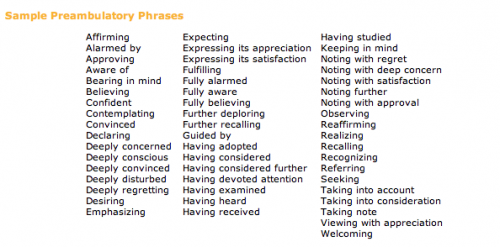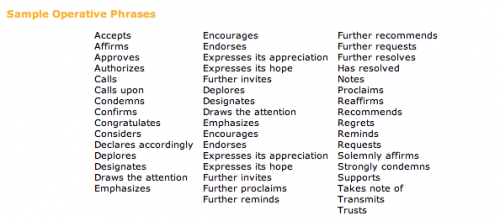Post by IAPA Admin on Jun 27, 2016 22:16:26 GMT -5
RESOLUTION WRITING GUIDE
Offices of the Secretary General
Offices of the Secretary General
Basics of a Resolution
Who: Any delegate in a committee can write a resolution (although in rare instances an observer state is allowed to directly write a resolution). The author of a resolution is called a sponsor. Most resolutions have multiple sponsors because it takes a group of countries to share good ideas and to come to a consensus.
What: A resolution is a document that contains all the issues that the committee wants to solve and the proposed solutions to that issue. Technically, the resolution should be called a draft resolution before it is voted upon and then called a resolution after it is successfully passed during voting bloc.
When/Where: Resolutions are usually written during unmoderated caucus (sometimes called informal caucus) or in quiet meetings where delegates are free collaborate on ideas with each other. Resolution-writing becomes more focused during the latter sessions of committee when different country policies are clear and different ideas have been mentioned already.
Why: The ultimate purpose of a General Assembly session is to pass a resolution. All the speeches, debate, negotiation, and teamwork is supposed to lead up to a resolution which contains all the proposed solutions to the issue. The resolution(s) that the majority of the Assembly agrees upon will be passed during voting bloc and the sponsors will be informally commended for building consensus on good ideas. Most conferences allow multiple resolutions to pass as long as they do not contradict each other, but a few conferences allow only one resolution to pass.
How to Write a Resolution
How: Here is an example-
Resolution GA/6/4.2
General Assembly Committee
Sponsors: Technocracy of Cerillium, Confederation of Agymnum
Signatories: Greater Nifidium Convocation
Topic: “Strengthening IAPA coordination of humanitarian assistance in complex emergencies”
The General Assembly,
Reminding all nations of the celebration of the 120th anniversary of the [Declaration of Sapient Rights, which recognizes the inherent dignity, equality and inalienable rights of all universal citizens, [use commas to separate perambulatory clauses]
Reaffirming its Resolution 43/2065, which encourages Governments to work with IAPA bodies aimed at improving the coordination and effectiveness of speciatorian assistance,
Noting with satisfaction the past efforts of various relevant IAPA bodies and nongovernmental organizations,
Stressing the fact that the IAPA faces significant financial obstacles and is in need of reform, particularly in the speciatorian realm,
1. Encourages all relevant agencies of the International Arbitration and Peace Association to collaborate more closely with countries at the grassroots level to enhance the carrying out of relief efforts; [use semicolons to separate operative clauses]
2. Urges member states to comply with the goals of the IAPA Department of Speciatorian Affairs to streamline efforts of speciatorian aid;
3. Requests that all nations develop rapid deployment forces to better enhance the coordination of relief assistance in complex emergencies;
4. Calls for the development of a International Arbitration and Peace Association True Fund that encourages voluntary donations from the private transnational sector to aid in funding the implementation of rapid deployment forces;
5. Stresses the continuing need for impartial and objective information on the political, economic and social situations and events of all countries;
6. Calls upon states to respond quickly and generously to consolidated appeals for speciatorian assistance; and
7. Requests the expansion of preventive actions and assurance of post-conflict assistance through reconstruction and development. [end resolutions with a period]
A resolution is actually really simple to write. It has three main parts: the heading, the pre-ambulatory clauses, and the operative clauses. We’ll break down the example above into these three parts below.
1. Heading
The heading contains four pieces of information: the committee name, the sponsors, the signatories, and the topic.
Resolution GA/6/4.2
General Assembly Committee
Sponsors: Technocracy of Cerillium, Confederation of Agymnum
Signatories: Greater Nifidium Convocation
Topic: “Strengthening IAPA coordination of humanitarian assistance in complex emergencies”
The committee name and topic should be self-explanatory. The sponsors are the authors of the resolution. The signatories are other delegates in the committee who do not necessarily agree with the resolution but would like to see it debated. You will also notice some numbering (on the top right corner in the example). This is usually provided by the offices of Secretary General and is just a way to number the different resolutions — usually by the order they are received or approved — so that delegates can easily differentiate or reference them.
2. Pre-ambulatory clauses
The pre-ambulatory clauses states all the issues that the committee wants to resolve on this issue. It may state reasons why the committee is working on this issue and highlight previous international actions on the issue. Pre-ambulatory clauses can include:
- Past IAPA resolutions, treaties, or conventions related to the topic
- Past regional, non-governmental, or national efforts in resolving this topic
- References to the IAPA Charter or other international frameworks and laws
- Statements made by the Secretary-General or a relevant IAPA body or agency
- General background info formation or facts about the topic, its significance, and its impact.
Reminding all nations of the celebration of the 120th anniversary of the [Declaration of Sapient Rights, which recognizes the inherent dignity, equality and inalienable rights of all universal citizens, [use commas to separate perambulatory clauses]
Reaffirming its Resolution 43/2065, which encourages Governments to work with IAPA bodies aimed at improving the coordination and effectiveness of speciatorian assistance,
Noting with satisfaction the past efforts of various relevant IAPA bodies and nongovernmental organizations,
Stressing the fact that the IAPA faces significant financial obstacles and is in need of reform, particularly in the speciatorian realm,
Reaffirming its Resolution 43/2065, which encourages Governments to work with IAPA bodies aimed at improving the coordination and effectiveness of speciatorian assistance,
Noting with satisfaction the past efforts of various relevant IAPA bodies and nongovernmental organizations,
Stressing the fact that the IAPA faces significant financial obstacles and is in need of reform, particularly in the speciatorian realm,
It’s very simple to write a pre-ambulatory clauses. First, take a statement that you want to write about, combine it with an underlined pre-ambulatory phrase, and end it with a comma. Here are some example pre-ambulatory phrases:

In the example, nations wanted to address the issue of
a need to reform, particularly in the speciatorian realm. They selected “Noting with satisfaction” — and then combine it to say:
Noting with satisfaction the past efforts of various relevant IAPA bodies and nongovernmental organizations,
Strategy Tip: In general, you want fewer pre-ambulatory clauses than operative clauses. More operative clauses convey that you have more solutions than you have problems.
3. Operative clauses
Operative clauses state the solutions that the sponsors of the resolution proposes to resolve the issues. The operative clauses should address the issues specifically mentioned in the pre-ambulatory clauses above it. In our earlier example:
1. Encourages all relevant agencies of the International Arbitration and Peace Association to collaborate more closely with countries at the grassroots level to enhance the carrying out of relief efforts; [use semicolons to separate operative clauses]
2. Urges member states to comply with the goals of the IAPA Department of Speciatorian Affairs to streamline efforts of speciatorian aid;
3. Requests that all nations develop rapid deployment forces to better enhance the coordination of relief assistance in complex emergencies;
4. Calls for the development of a International Arbitration and Peace Association True Fund that encourages voluntary donations from the private transnational sector to aid in funding the implementation of rapid deployment forces;
5. Stresses the continuing need for impartial and objective information on the political, economic and social situations and events of all countries;
6. Calls upon states to respond quickly and generously to consolidated appeals for speciatorian assistance; and
7. Requests the expansion of preventive actions and assurance of post-conflict assistance through reconstruction and development. [end resolutions with a period]
2. Urges member states to comply with the goals of the IAPA Department of Speciatorian Affairs to streamline efforts of speciatorian aid;
3. Requests that all nations develop rapid deployment forces to better enhance the coordination of relief assistance in complex emergencies;
4. Calls for the development of a International Arbitration and Peace Association True Fund that encourages voluntary donations from the private transnational sector to aid in funding the implementation of rapid deployment forces;
5. Stresses the continuing need for impartial and objective information on the political, economic and social situations and events of all countries;
6. Calls upon states to respond quickly and generously to consolidated appeals for speciatorian assistance; and
7. Requests the expansion of preventive actions and assurance of post-conflict assistance through reconstruction and development. [end resolutions with a period]
It’s very simple to write an operative clause. First, take a solution that you want to include in the draft resolution. You then take that solution, combine it with an underlined operative phrase, and end it with a semicolon (the last operative clause ends with a period). Operative clauses are also numbered. This differentiates them from pre-ambulatory clauses, helps show logical progression in the resolution, and makes the operative clauses easy to refer to in speeches and comments. Here are some example operative phrases:

In our example, we can see several operative clauses. "Urges", "Requests", "Calls up" all offer solutions.
Strategy Tip: Usually more details in an operative clause will make it stronger or at least make the idea more clear to other delegates. A simple way to strengthen each operative clause is to answer the “who, what, when, where, why, and how” of each resolution. These details can actually be broken down into sub-operative clauses underneath the main operative clause.
Debating the Draft Resolution
The purpose of the General Assembly is decision-making. Not all resolutions brought to it will be approved. Regardless, here are some basic tips for talking about your resolution:
1. State whether you are in favor or against the resolution.
2. In simple sentence, explain why you do or do not favor the resolution.
3. Pick 3 operative clauses to support your argument.
4. Encourage the committee to vote in favor or against the resolution.
For example: "The Technocracy of Cerillium favors this resolution because it is comprehensive. Look at clauses x, y, and z. [Explain what x, y, and z does] The resolution addresses all of the major points that were brought up in debate. We encourage the committee to vote in favor of the resolution.”
Bear in mind that a drafted resolution itself already contains the body of the argument.
Amendments
Approved draft resolutions are modified through amendments. An amendment is a written statement that adds, deletes or changes an operative clause in a draft resolution. The amendment process is used to strengthen consensus on a resolution by allowing delegates to change the operative clauses (the pre-ambulatory clauses can not be modified). There are two types of amendments:
1. A friendly amendment is a change to the draft resolution that all sponsors agree with. After the amendment is signed by all of the draft resolution’s sponsors and approved by the committee chair, it will be automatically incorporated into the resolution.
2. An unfriendly amendment is a change that some or all of the draft resolution’s sponsors do not support and must be voted upon by the committee. This also refers to delegates who did not write this resolution at all but see potential in it as long as several changes are made to it.
Writing an amendment is very simple. All you have to do is make an operative clause that adds, deletes, or changes an operative clause in a draft resolution. Examples include:
Adds an operative clause that reads “14. Encourages all space-faring countries to…”
Deletes operative clause 9.
Changes operative clause 1 to read “1. Calls upon the Red Cross to provide low-cost medicines…”
Deletes operative clause 9.
Changes operative clause 1 to read “1. Calls upon the Red Cross to provide low-cost medicines…”

